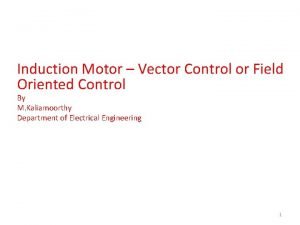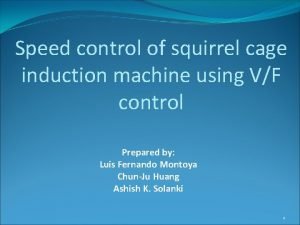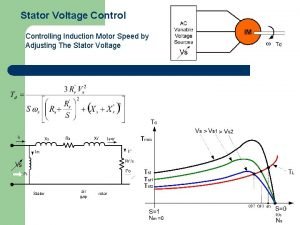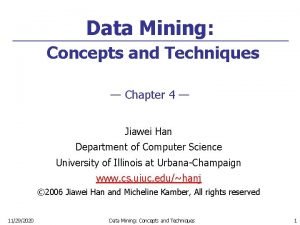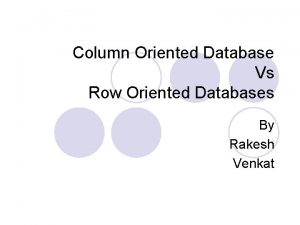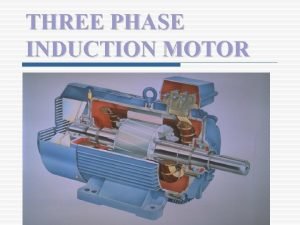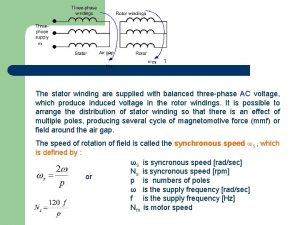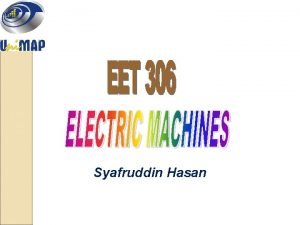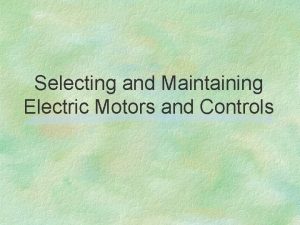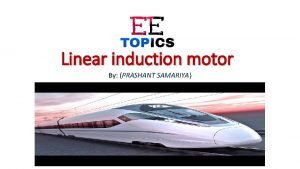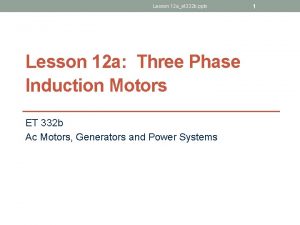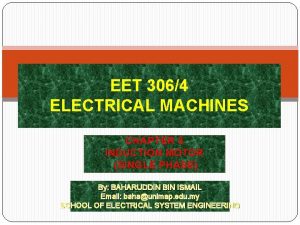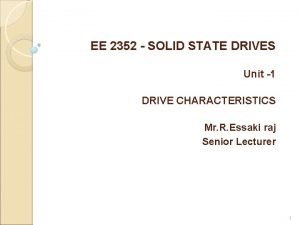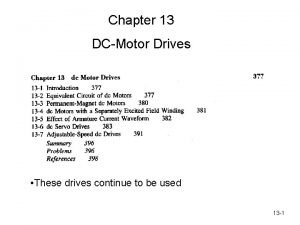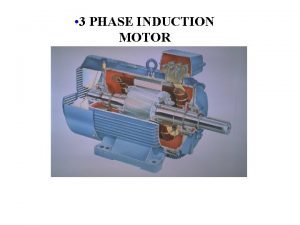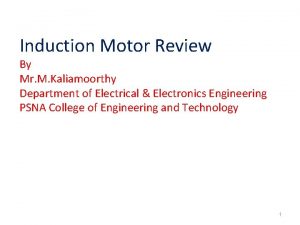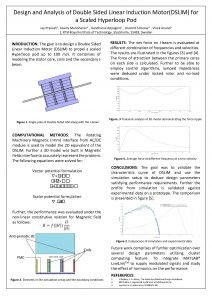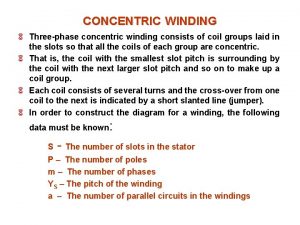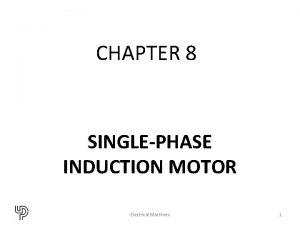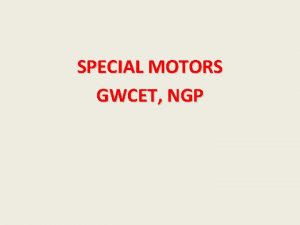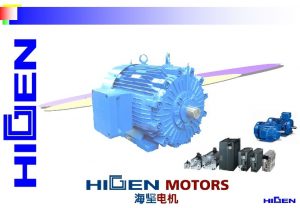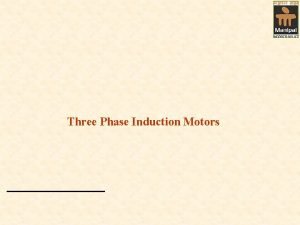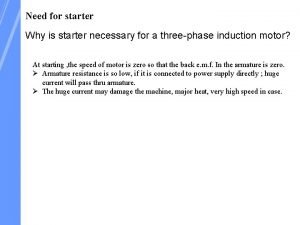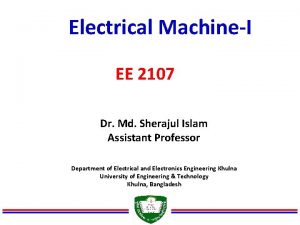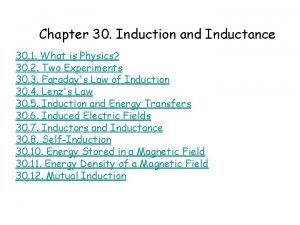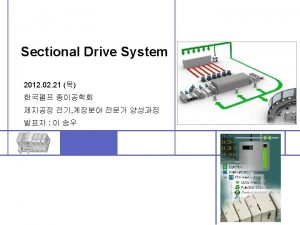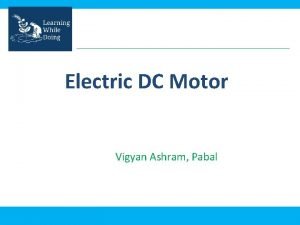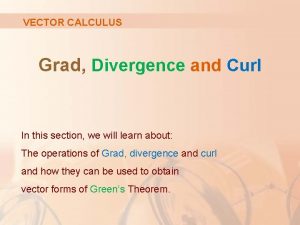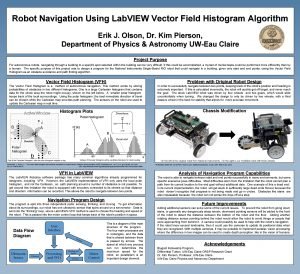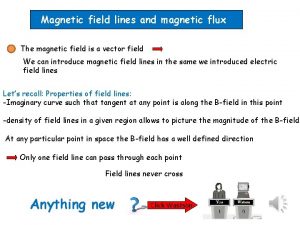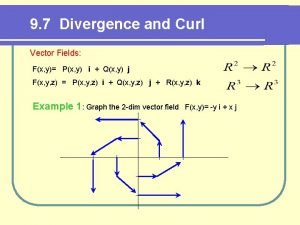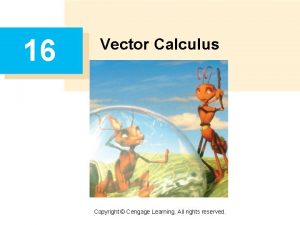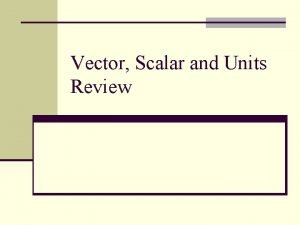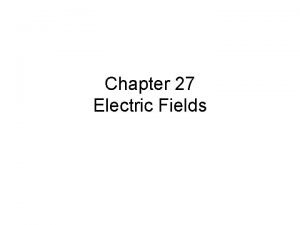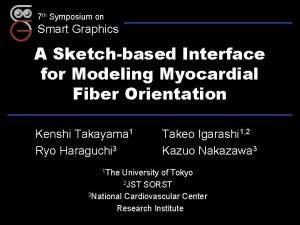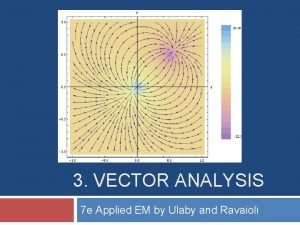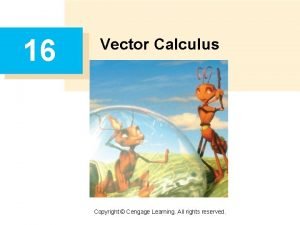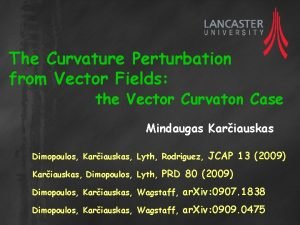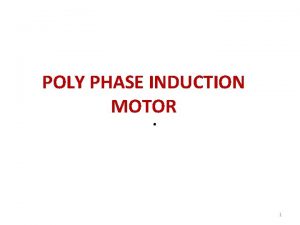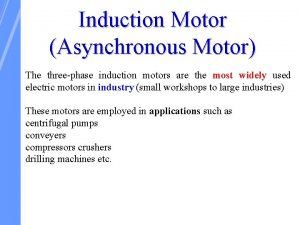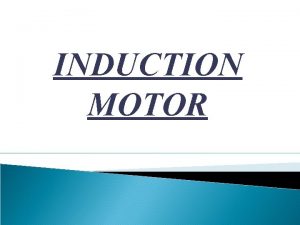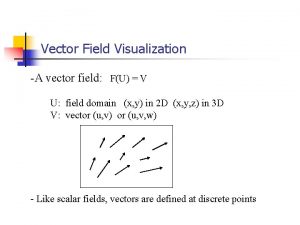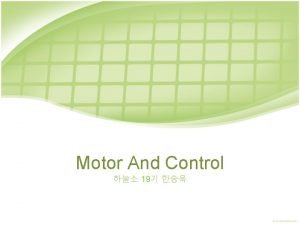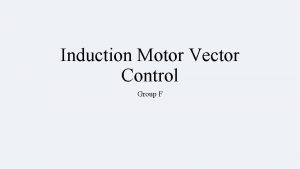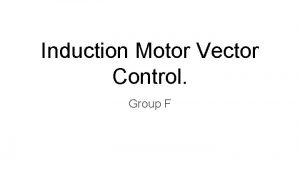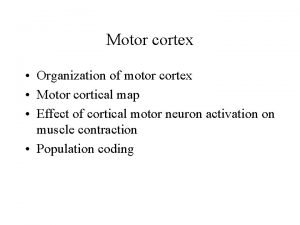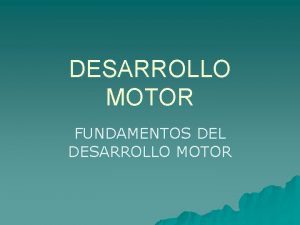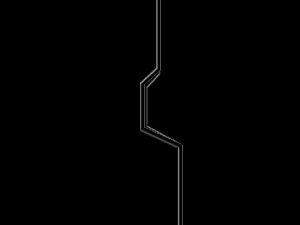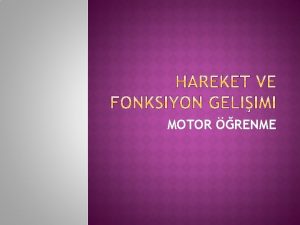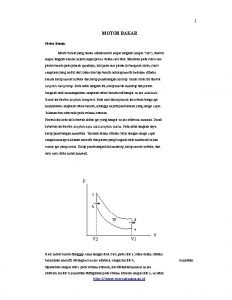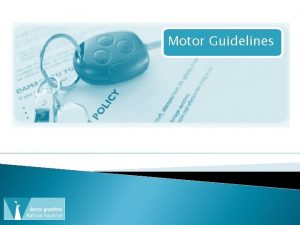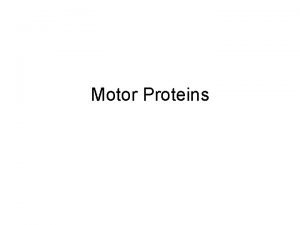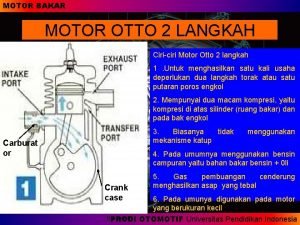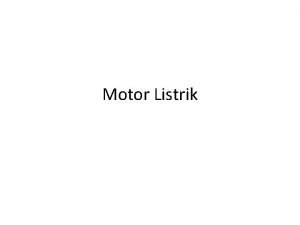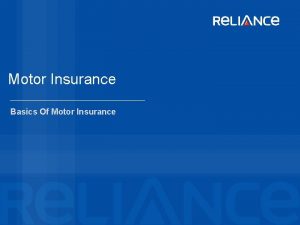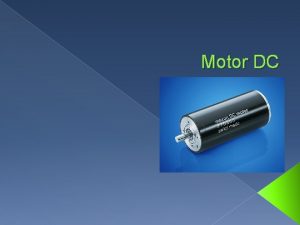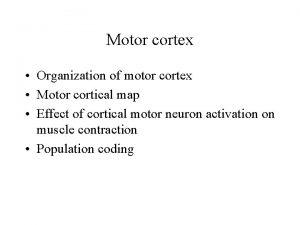Induction Motor Vector Control or Field Oriented Control


















































- Slides: 50

Induction Motor – Vector Control or Field Oriented Control By M. Kaliamoorthy Department of Electrical Engineering 1

Outline Introduction Analogy to DC Drive Principles of Field Orientation Control Rotor Flux Orientation Control Indirect Rotor Flux Orientation (IRFO) Direct Rotor Flux Orientation (DRFO) Stator Flux Orientation Control Direct Stator Flux Orientation (DSFO) References 2

Introduction Induction Motor (IM) drives are replacing DC drives because: Induction motor is simpler, smaller in size, less maintenance Less cost Capability of faster torque response Capability of faster speed response (due to lower inertia) DC motor is superior to IM with respect to ease of control High performance with simple control Due to decoupling component of torque and flux 3

Introduction Induction Motor Drive Scalar Control • Control of current/voltage/frequency magnitude based on steady-state equivalent circuit model • ignores transient conditions • for low performance drives • Simplementation • Inherent coupling of torque and flux • Both are functions of voltage and frequency • Leads to sluggish response • Easily prone to instability Vector Control or Field Orientation Control • control of magnitude and phase of currents and voltages based on dynamic model • Capable of observing steady state & transient motor behaviour • for high performance drives • Complex implementation • Decoupling of torque and flux • similar to the DC drive • Suitable for all applications previously covered by DC drives 4

Analogy to DC Drive In the DC motor: Te = k f Ia f controlled by controlling If If same direction as field f Ia same direction as field a Ia and f always perpendicular and decoupled • Hence, Te = k f Ia • • • = k’ If Ia sin 90 = k’(If x Ia) f a • Keeping f constant, Te controlled by controlling Ia • Ia, If , a and f are space vectors 5

Analogy to DC Motor • In the Induction Motor: s c’ b r a b’ c Te = k r x s • s produced by stator currents • r produced by induced rotor currents • Both s and r rotates at synchronous speed s • Angle between s and r varies with load, and motor speed r • Torque and flux are coupled. 6

Analogy to DC Motor • Induction Motor torque equation : (1) (2) • Compared with DC Motor torque equation: (3) • Hence, if the angle between s or r and is is made to be 90 , then the IM will behave like a DC motor. 7

Principles of Field Orientation Control • Hence, if the angle between s or r and is is made to be 90 , then the IM will behave like a DC motor. Achieved through orientation (alignment) of rotating dq frame on r or s Rotor-Flux Orientation Control Stator-Flux Orientation Control 8

Principles of Field Orientation Control Rotor-Flux Orientation Control Stator-Flux Orientation Control qs qs q r q s d r ds ds 9

Principles of Field Orientation Control • Summary of field orientation control on a selected flux vector f (i. e. either r , s or m): 1 2 3 • In revolving (rotating) d fq f - reference frame, obtain • isq f* from given rotor speed reference r* (via speed controller) • isd f* from given flux reference f* • Determine the angular position f of f (i. e. reference frame orientation angle) • used in the d fq f dsqs conversion from vsdq f* (output of isdq f* current controller) to vsdqs*. • In the stationary dsqs - frame, obtain the reference stator voltages vabcs* • fed to the PWM inverter feeding the IM from vsdqs* using the dsqs abc transformation. 10

Rotor Flux Orientation Control qs • d- axis of dq- rotating frame is aligned with r. Hence, q r (4) d r (5) • Therefore, r (6) ds Ø = torque producing current Ø = field producing current Similar to ia & if in DC motor Decoupled torque and flux control 11

Rotor Flux Orientation Control From the dynamic model of IM, if dq- frame rotates at general speed g (in terms of vsd, vsq, isd, isq, ird, irq) : (7) r rotates at synchronous speed s Hence, d rq r- frame rotates at s Therefore, g = s These voltage equations are in terms of isd, isq, ird, irq Better to have equations in terms of isd, isq, rd, rq (8) 12

Rotor Flux Orientation Control • Rotor flux linkage is given by: • From (9): (9) (10) • Substituting (8) and (10) into (7) gives the IM voltage equations rotating at s in terms of vsd, vsq, isd, isq, rd, rq: (11) 13

Rotor Flux Orientation Control • Since , hence the equations in rotor flux orientation are: (12) (13) (14) (15) Important equations for Rotor Flux Orientation Control! Note: Total leakage factor = sl = slip speed (elec. ) 14

Rotor Flux Orientation Control • Let • Using (16), equation (14) can be rearranged to give: (16) (17) • is called the “equivalent magnetising current” or “field current” (18) • Hence, from (17): where • Under steady-state conditions (i. e. constant flux): (19) 15

Rotor Flux Orientation Control qs • r rotates at synchronous speed s • d rq r- frame also rotates at s • Hence, q r d r r ds dq- reference frame orientation angle • For precise control, r must be (20) obtained at every instant in time • Leads to two types of control: – Indirect Rotor Flux Orientation – Direct Rotor Flux Orientation 16

Indirect Rotor Flux Orientation (IRFO) • Orientation angle: • Synchronous speed obtained by adding slip speed and electrical rotor speed • Slip speed can be obtained from equation (15): (21) (22) • Under steady-state conditions ( ): (23) 17

Indirect Rotor Flux Orientation (IRFO) - implementation Closed-loop implementation under constant flux condition: 1. Obtain isd r* from r* using (16): (24) Obtain isq r* from outer speed control loop since isq r* Tm* based on (6): (25) Obtain vsdq r* from isdq r* via inner current control loop. 18

Indirect Rotor Flux Orientation (IRFO) - implementation Closed-loop implementation under constant flux condition: 2. Determine the angular position r using (21) and (23): (26) where m is the measured mechanical speed of the motor obtained from a tachogenerator or digital encoder. r to be used in the d rq r dsqs conversion of stator voltage (i. e. vsdq r* to vsdqs* concersion). 19

Indirect Rotor Flux Orientation (IRFO) - implementation d rq r dsqs transformation Rotating frame (d rq r) isd r* r* Eq. (24) + isq r* + - PI + - - PI NO field weakening (constant flux) slip + ej r vsds* r + r 2/3 e-j r isqs vbs* vcs* PWM VSI IRFO Scheme P/2 m ias isd r isq r vas* vsqs* PI isd r* isq r* Eq. (23) Staionary frame (dsqs) vsd r* vsq r* 2 -phase (dsqs ) to 3 -phase (abc) transformation 3/2 ibs ics 20

Indirect Rotor Flux Orientation (IRFO) - implementation d rq r dsqs transformation vsqs* vsd r* vsq r* ej r vsds* dsqs d rq r transformation isds isd r isq r e-j r isqs 21

Indirect Rotor Flux Orientation (IRFO) - implementation • 2 -phase (dsqs ) to 3 -phase (abc) transformation: vas* vsqs* vsds* 2/3 vbs* vcs* • 3 -phase (abc) to 2 -phase (dsqs ) transform is given by: ias isds where: isqs 3/2 ibs ics and 22

Example – IRFO Control of IM • An induction motor has the following parameters: Parameter Symbol Value Rated power Prat 30 hp (22. 4 k. W) Stator connection No. of poles Delta ( ) P 6 Rated stator phase Vs, rat voltage (rms) 230 V Rated stator phase current (rms) Is, rat 39. 5 A Rated frequency frat 60 Hz Rated speed nrat 1168 rpm 23

Example – IRFO Control of IM ctd. Parameter Symbol Value Rated torque Te, rat 183 Nm Stator resistance Rs 0. 294 Stator self inductance Referred rotor resistance Ls 0. 0424 H Rr’ 0. 156 Referred rotor self inductance Lr’ 0. 0417 H Mutual inductance Lm 0. 041 H 24

Example – IRFO Control of IM ctd. The motor above operates in the indirect rotor field orientation (IRFO) scheme, with the flux and torque commands equal to the respective rated values, that is r* = 0. 7865 Wb and Te* = 183 Nm. At the instant t = 1 s since starting the motor, the rotor has made 8 revolutions. Determine at time t = 1 s: 1. the stator reference currents isd* and isq* in the dq-rotating frame 2. the slip speed sl of the motor 3. the orientation angle r of the dq-rotating frame 4. the stator reference currents isds* and isqs* in the stationary dsqs frame 5. the three-phase stator reference currents ias*, ibs* and ics* 25

Example – IRFO Control of IM ctd. • Answers: 26

Indirect Rotor Flux Orientation (IRFO) – field weakening • Closed-loop implementation under field weakening condition: – Employed for operations above base speed – DC motor: flux weakened by reducing field current if imrd* – Compared with eq. (17) for IM: – IM: flux weakened by reducing imrd (i. e. “equivalent magnetising current” or “field current) imrd (rated) r (base) r 27

Indirect Rotor Flux Orientation (IRFO) – field weakening implementation With field weakening r* Rotating frame (d rq r) Staionary frame (dsqs) imrd r * + imrd r isd r* PI r*+ - + PI imrd isq r* + r* - PI vsd r* vsq r* ej r PI isq r* Eq. (22) vsqs* slip + r r Same as in slide 20 + isds isd r isq r vsds* e-j r isqs 28

Indirect Rotor Flux Orientation (IRFO) – Parameter sensitivity Mismatch between IRFO Controller and IM may occur due to parameter changes with operating conditions (eg. increase in temperature, saturation) Mismatch causes coupling between T and producing components Consequences: r deviates from reference value (i. e. r*) Te deviates in a non-linear relationship from command value (i. e. Te*) Oscillations occurs in r and Te response during torque transients (settling time of oscillations = r) 29

Direct Rotor Flux Orientation (DRFO) • Orientation angle: (27) obtained from: 1. Direct measurements of airgap fluxes mds and mqs 2. Estimated from motor’s stator voltages vsdqs and stator currents isdqs Note that: (28) 30

Direct Rotor Flux Orientation (DRFO) – Direct measurements mds & mqs 1. Direct measurements of airgap fluxes mds and mqs measured using: Hall sensors – fragile flux sensing coils on the stator windings – voltages induced in coils are integrated to obtain mds and mqs The rotor flux r is then obtained from: (29) Disadvantages: sensors are inconvenient and spoil the ruggedness of IM. 31

Direct Rotor Flux Orientation (DRFO) – Direct measurements mds & mqs Rotating frame isd r* r* Eq. (24) + isq r* + PI - r NO field weakening (constant flux) + - - (d rq r) PI Stationary frame vsd r* vsq r* PI DRFO r Scheme tan-1 isd r isq r r e-j r vsds* 2/3 vbs* vcs* mds rqs Eq. (29) mqs P/2 PWM VSI m ias isds isqs Flux sensing coils arranged in quadrature vas* vsqs* ej r (dsqs) 3/2 ibs ics 32

Direct Rotor Flux Orientation (DRFO) – Estimated from vsdqs & isdqs 2. Estimated from motor’s stator voltages and currents sds and sqs obtained from stator voltage equations: (30) The rotor flux r is then obtained from: (31) Disadvantages: dc-drift due to noise in electronic circuits employed, incorrect initial values of flux vector components sdq(0) 33

Direct Rotor Flux Orientation (DRFO) – Estimated from vsdqs & isdqs 2. Estimated from motor’s stator voltages and currents This scheme is part of sensorless drive scheme using machine parameters, voltages and currents to estimate flux and speed sdqs calculations (eq. 30) depends on Rs Poor field orientation at low speeds ( < 2 Hz), above 2 Hz, DRFO scheme as good as IRFO Solution: add boost voltage to vsdqs at low speeds Disadvantages: Parameter sensitive, dc-drift due to noise in electronic circuits employed, incorrect initial values of flux vector components sdq(0) 34

Direct Rotor Flux Orientation (DRFO) – Estimated from vsdqs & isdqs Rotating frame (d rq r) Stationary frame (dsqs) isd r* r* Eq. (24) + isq r* + PI - r NO field weakening (constant flux) + - - PI vsd r* vsq r* ej r PI DRFO r Scheme tan-1 isd r isq r vas* vsqs* r e-j r vsds* 2/3 vbs* vcs* PWM VSI sds rds vsdqs rqs Eq. (31) sqs Eq. (30) isdqs m P/2 ias isds isqs 3/2 ibs ics 35

Direct Rotor Flux Orientation (DRFO) – field weakening implementation With field weakening r* Rotating frame (d rq r) Stationary frame (dsqs) imrd r * + imrd r isd r* PI r*+ - PI + isq r* + - PI vsd r* vsqs* ej r PI r tan-1 isd r isq r r e-j r vsds* rds rqs r Same as in slide 26 or 29 isds isqs 36

Stator Flux Orientation Control • d- axis of dq- rotating frame is aligned with s. Hence, qs q s (32) d s (33) • Therefore, (34) ds Ø = torque producing current Ø = field producing current Similar to ia & if in DC motor Decoupled torque and flux control 37

Stator Flux Orientation Control From the dynamic model of IM, if dq- frame rotates at general speed g (in terms of vsd, vsq, isd, isq, ird, irq): (7) s rotates at synchronous speed s Hence, d sq s- frame rotates at s Therefore, g = s These voltage equations are in terms of isd, isq, ird, irq Better to have equations in terms of isd, isq, sd, sq (8) 38

Stator Flux Orientation Control • Stator flux linkage is given by: • From (9): (35) (36) • Substituting (8) and (36) into (7) gives the IM voltage equations rotating at s in terms of vsd, vsq, isd, isq, sd, sq: (37) 39

Stator Flux Orientation Control • Since , hence the equations in stator flux orientation are: (38) (39) (40) (41) Important equations for Stator Flux Orientation Control! 40

Stator Flux Orientation Control • Equation (40) can be rearranged to give: (42) • should be independent of torque producing current • From (42), is proportional to and . • Coupling exists between and . Varying to control torque causes change in Torque will not react immediately to 41

Stator Flux Orientation Control – Dynamic Decoupling • De-coupler is required to – overcome the coupling between and (so that has no effect on ) – Provide the reference value for • Rearranging eq. (42) gives: (43) • can be obtained from outer speed control loop • However, eq. (43) requires 42

Stator Flux Orientation Control – Dynamic Decoupling • can be obtained from (41): (44) • in (43) and (44) is the reference stator flux vector • Hence, equations (43) and (44) provide dynamic decoupling of the flux-producing and torque-producing currents. 43

Stator Flux Orientation Control – Dynamic Decoupling • Dynamic decoupling system implementation: + s* isd s* + isq s* x from speed controller x sl* 44

Stator Flux Orientation Control d sq s- frame also rotates at s For precise control, s must be obtained at every instant in time Leads to two types of control: qs q s d s s dq- reference frame orientation angle Indirect Stator Flux Orientation Direct Stator Flux Orientation s easily estimated from motor’s s and stator voltages v sdq ds currents isdqs Hence, Indirect Stator Flux Orientation scheme 45 unessential.

Direct Stator Flux Orientation (DSFO) - implementation Closed-loop implementation: 1. Obtain isd s* from s control loop and dynamic decoupling system shown in slide 38. Obtain isq s* from outer speed control loop since isq r* Te* based on (34): (45) Obtain vsdq s* from isdq s* via inner current control loop. 46

Direct Stator Flux Orientation (DSFO) - implementation Closed-loop implementation: 2. Determine the angular position s using: (46) sds and sqs obtained from stator voltage equations: (47) Note that: (48) Eq. (48) will be used as feedback for the s control loop 47

Direct Stator Flux Orientation (DSFO) - implementation Closed-loop implementation: 3. s to be used in the d sq s dsqs conversion of stator voltage (i. e. vsdq s* to vsdqs* concersion). s estimated from pure integration of motor’s stator voltages equations eq. (47) which has disadvantages of: dc-drift due to noise in electronic circuits employed incorrect initial values of flux vector components sdqs(0) Solution: A low-pass filter can be used to replace the pure integrator and avoid the problems above. 48

Direct Stator Flux Orientation (DSFO) - implementation r r* + s* - PI isq s* + - Decoupling system + i s* sd + + PI - | | PI vsq s* vsd s* sds sqs vsqs* ej s PI s + - tan-1 isq s s Eq. (48) P/2 isd s s e-j s vsds* sds 2/3 vas* PWM VSI vbs* vcs* vsdqs Eq. (47) isdqs sqs ias isqs isds m 3/2 ibs ics Rotating frame (d sq s ) Stationary frame (dsqs ) 49

References • Trzynadlowski, A. M. , Control of Induction Motors, Academic Press, San Diego, 2001. • Krishnan, R. , Electric Motor Drives: Modeling, Analysis and Control, Prentice-Hall, New Jersey, 2001. • Bose, B. K. , Modern Power Electronics and AC drives, Prentice. Hall, New Jersey, 2002. • Asher, G. M, Vector Control of Induction Motor Course Notes, University of Nottingham, UK, 2002. 50
 Principle of vector control of induction motor
Principle of vector control of induction motor Speed control of squirrel cage induction motor
Speed control of squirrel cage induction motor Stator voltage control of induction motor
Stator voltage control of induction motor Single phase ac voltage controller using triac
Single phase ac voltage controller using triac Attribute oriented induction in data mining
Attribute oriented induction in data mining Trade oriented sales promotion
Trade oriented sales promotion Row oriented database
Row oriented database Slip formula
Slip formula Air gap power in induction motor formula
Air gap power in induction motor formula Power flow diagram of motor
Power flow diagram of motor Repulsion start induction run motor
Repulsion start induction run motor Construction of linear induction motor
Construction of linear induction motor Rotor frequency formula
Rotor frequency formula Air gap power in induction motor formula
Air gap power in induction motor formula Ee2352 solid state drives
Ee2352 solid state drives 4 quadrant operation of induction motor
4 quadrant operation of induction motor 3-phase induction motor problems and solutions
3-phase induction motor problems and solutions Induction motor voltage equation
Induction motor voltage equation Linear induction motor hyperloop
Linear induction motor hyperloop Concentric winding induction motor
Concentric winding induction motor Single phase induction motor
Single phase induction motor Repulsion start induction run motor
Repulsion start induction run motor Higen 3 phase induction motor
Higen 3 phase induction motor Power stages of 3 phase induction motor
Power stages of 3 phase induction motor Slip of induction motor
Slip of induction motor Application of induction motor
Application of induction motor Capacitive field diathermy
Capacitive field diathermy Induced current
Induced current Sectional drive
Sectional drive Unit vector examples
Unit vector examples Vector
Vector Vector resolution examples
Vector resolution examples A position vector is
A position vector is Pony motor starting method
Pony motor starting method Motor neuron vs motor unit
Motor neuron vs motor unit Synchronous motor hunting
Synchronous motor hunting Ac motor vs dc motor
Ac motor vs dc motor Ee 216
Ee 216 Curl of vector in cylindrical coordinates
Curl of vector in cylindrical coordinates Vector field histogram
Vector field histogram Flux of a vector field
Flux of a vector field Divergence of f
Divergence of f Surface integral
Surface integral Scalar units
Scalar units Electric field equations
Electric field equations Vector field sketcher
Vector field sketcher Length of a vector
Length of a vector Curl of the vector field
Curl of the vector field Vector field
Vector field 21lwuy8i6hw -site:youtube.com
21lwuy8i6hw -site:youtube.com Individual differences factors
Individual differences factors
